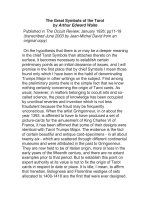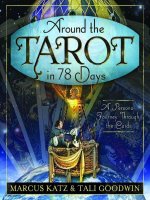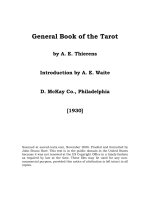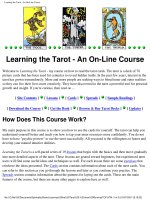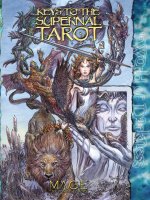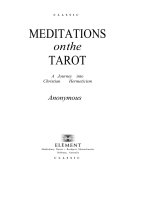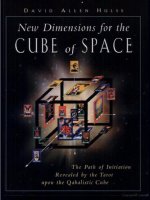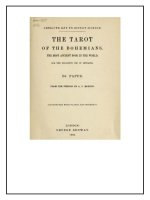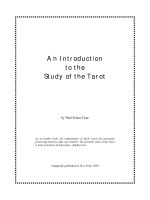Hướng dẫn bói bài Tarot Learning the tarot
Bạn đang xem bản rút gọn của tài liệu. Xem và tải ngay bản đầy đủ của tài liệu tại đây (4.05 MB, 547 trang )
Learning the Tarot - An On-Line Course
Learning the Tarot - An On-Line Course
Welcome to Learning the Tarot - my course on how to read the tarot cards. The tarot is a deck of 78
picture cards that has been used for centuries to reveal hidden truths. In the past few years, interest in the
tarot has grown tremendously. More and more people are seeking ways to blend inner and outer realities
so they can live their lives more creatively. They have discovered in the tarot a powerful tool for personal
growth and insight. If you're curious, then read on ...
[ Site Contents ]
[ Download the Course ]
[ Lessons ]
[ Cards ]
[ Get the Book ]
[ Spreads ]
[ Sample Readings ]
[ Browse & Buy Tarot Decks ]
[ Updates ]
How Does This Course Work?
My main purpose in this course is to show you how to use the cards for yourself. The tarot can help you
understand yourself better and teach you how to tap your inner resources more confidently. You do not
have to have "psychic powers" to use the tarot successfully. All you need is the willingness to honor and
develop your natural intuitive abilities.
Learning the Tarot is a self-paced series of 19 lessons that begin with the basics and then move gradually
into more detailed aspects of the tarot. These lessons are geared toward beginners, but experienced tarot
users will find some useful ideas and techniques as well. For each lesson there are some exercises that
reinforce the ideas presented. The Cards section contains information about each of the tarot cards. You
can refer to this section as you go through the lessons and later as you continue your practice. The
Spreads section contains information about the patterns for laying out the cards. These are the main
features of the course, but there are many other pages to explore here as well.
file:///C|/My%20Documents/Spiritoality/Books/Learning%20the%20Tarot%20-%20Joan%20Bunning/TOP.HTM (1 of 3) [15/07/2001 20:16:23]
Learning the Tarot - An On-Line Course
What Is Needed For the Course?
The only real requirement for this course is a tarot deck. If you don't have a deck, read through my
comments on buying your first deck and then browse through my Tarot Deck Section. Nowadays, there
are many choices. The on-line version of Learning the Tarot is illustrated with the popular Rider-Waite
deck. This is a good deck to start with because there are pictures on every card which helps when you are
learning. If you already have a different 78 card deck, you may use it with the course. The principles of
tarot work are much the same no matter what deck you use. You can buy tarot decks in many places now.
Bookstores often carry them, and many internet sites offer a variety of tarot decks for sale. If you have
trouble finding a deck in your area, you can order one from me.
What is the History of this Course?
I began writing this course in 1989. I had been studying the tarot for
some years, and I found that I was developing some ideas about the
cards and how they could be used as a tool for inner guidance. In
October 1995, I created this website. In October 1998, Learning the
Tarot was published as a paperback.
My experience with the cards is in doing readings for myself, friends,
relatives and acquaintances...probably the kind of tarot you are
interested in. The tarot cards are not difficult to learn, but there is
always more to them that can be learned. They are deceptively simple,
but surprisingly rich.
How Can I Take This Course?
Internet: You can use this course while connected to the Internet, just as you are now. The course is free,
but please read the copyright message first. When you're ready, go to the contents page and begin
exploring!
At Home: You can download the course to your own computer for personal use at home (while not
connected to the Internet). You can also order Learning the Tarot from me in paperback or on diskettes
or purchase the book from a local or on-line bookstore.
Some people worry that working with the tarot will involve them in occult practices or create conflicts
with their religious beliefs. My approach to the cards is simple and natural. I try to show that the cards
file:///C|/My%20Documents/Spiritoality/Books/Learning%20the%20Tarot%20-%20Joan%20Bunning/TOP.HTM (2 of 3) [15/07/2001 20:16:23]
Learning the Tarot - An On-Line Course
are not dark and mysterious, but wonderful tools for self-discovery. In fact, I feel that using the tarot can
expand your spiritual awareness in many positive ways.
Others may believe that the tarot is unscientific - a plaything at best, but certainly not to be taken
seriously by those who know better. I ask only that you indulge your curiosity and be willing to explore
the cards with an open mind. After all, that is the true spirit of scientific endeavor!
I hope you're intrigued enough to try this course. If you're still not sure, read Lesson 1. I think you will
find Learning the Tarot interesting at least, and perhaps the tool you have been looking for to develop
your unrealized potential. Have fun and good luck!
Copyright © 1995-2000 by Joan Bunning
"Illustrations from the Rider-Waite Tarot Deck (R), known also as the Rider Tarot and the
Waite Tarot, reproduced by permission of U. S. Games Systems, Inc., Stamford, CT 06902
USA. Copyright © 1971 by U.S. Games Systems, Inc. Further reproduction prohibited.
The Rider-Waite Tarot Deck (R) is a registered trademark of U.S. Games Systems, Inc.
file:///C|/My%20Documents/Spiritoality/Books/Learning%20the%20Tarot%20-%20Joan%20Bunning/TOP.HTM (3 of 3) [15/07/2001 20:16:23]
Tarot Course Table of Contents
Table of Contents
Welcome Lessons Exercises Cards Spreads Readings Charts Miscellaneous Decks Order
Lessons
●
●
●
●
Introduction
❍ Lesson 1 - Introduction to the Tarot
--- A little history, some philosophy and a rationale.
Elements of the Tarot
❍ Lesson 2 - The Major Arcana
--- Fool's Journey
❍ Lesson 3 - The Minor Arcana
❍ Lesson 4 - The Spread
Doing Readings
❍ Lesson 5 - The Daily Reading
❍ Lesson 6 - The Environment - inner and outer
❍ Lesson 7 - Writing a Question
❍ Lesson 8 - The Question Reading
--- Shuffling Methods
--- Step-by-Step Procedure
❍ Lesson 9 - The Other Reading
--- Step-by-Step Procedure
❍ Lesson 10 - The Open Reading
--- Step-by-Step Procedure
Principles of Interpretation
❍ Introduction
❍ Lesson 11 - Interpreting a Single Card
❍ Lesson 12 - Major and Minor Arcana Cards
❍ Lesson 13 - Aces
❍ Lesson 14 - Court Cards
❍ Lesson 15 - Card Pairs
❍ Lesson 16 - Position Pairs in the Celtic Cross Spread
❍ Lesson 17 - Reversed Cards
file:///C|/My%20Documents/Spiritoality/Books/Le...g%20the%20Tarot%20-%20Joan%20Bunning/course.htm (1 of 4) [15/07/2001 20:16:25]
Tarot Course Table of Contents
❍
●
Lesson 18 - Creating the Story
Closing
❍ Lesson 19 - Some Final Thoughts
--- A few closing thoughts about the meaning and purpose of tarot work.
Exercises
●
●
●
●
●
●
●
●
●
●
●
●
●
●
●
●
●
●
●
●
Introduction to Exercises
Exercises - Lesson 1 - Introduction to the Tarot
Exercises - Lesson 2 - The Major Arcana
Exercises - Lesson 3 - The Minor Arcana --- Suggestions
Exercises - Lesson 4 - The Spread
Exercises - Lesson 5 - The Daily Reading
Exercises - Lesson 6 - The Environment
Exercises - Lesson 7 - Writing a Question
Exercises - Lesson 8 - The Question Reading
Exercises - Lesson 9 - The Other Reading
Exercises - Lesson 10 - The Open Reading
Exercises - Lesson 11 - Interpreting a Single Card
Exercises - Lesson 12 - Major and Minor Arcana Cards --- Suggestions
Exercises - Lesson 13 - Aces
Exercises - Lesson 14 - Court Cards --- Suggestions
Exercises - Lesson 15 - Card Pairs --- Suggestions
Exercises - Lesson 16 - Position Pairs in the Celtic Cross --- Suggestions
Exercises - Lesson 17 - Reversed Cards --- Suggestions
Exercises - Lesson 18 - Creating the Story
Exercises - Lesson 19 - Some Final Thoughts
Card Information Pages
●
●
Introduction
Individual Card Descriptions
Spread Information Pages
●
●
Introduction
Spread Descriptions
file:///C|/My%20Documents/Spiritoality/Books/Le...g%20the%20Tarot%20-%20Joan%20Bunning/course.htm (2 of 4) [15/07/2001 20:16:25]
Tarot Course Table of Contents
❍
❍
Celtic Cross
Yin Yang
Sample Readings
●
●
Jill's Tale - Series of Three Celtic Cross Readings
❍ First Reading
❍ Second Reading
❍ Third Reading
Other Readings
❍ President Clinton/Monica Lewinsky - Aug 1998
❍ President Clinton/Monica Lewinsky - Feb 1998
❍ Presidental Election - Sept 1996
❍ Budget Crisis - Dec 1995
❍ Bosnia - Nov 1995
❍ Earth Changes - Oct 1995
❍ O. J. Simpson - Sept 1995
Charts
●
Cards
Major Arcana
❍ Minor Arcana - Ace through Ten
❍ Minor Arcana - Court Cards
Spreads
❍ Celtic Cross Spread
Suit Qualities
❍ Wands
❍ Cups
❍ Swords
❍ Pentacles
Court Card Pairs
❍ Page/Page
❍ Page/Knight
❍ Knight/Knight
❍ Queen or King/Page
❍ Queen or King/Knight
❍ Queen/Queen
❍
●
●
●
file:///C|/My%20Documents/Spiritoality/Books/Le...g%20the%20Tarot%20-%20Joan%20Bunning/course.htm (3 of 4) [15/07/2001 20:16:25]
Tarot Course Table of Contents
Queen/King
❍ King/King
Suit Pairs
❍ Wands/Cups
❍ Wands/Swords
❍ Swords/Cups
❍ Swords/Pentacles
❍ Pentacles/Cups
❍ Pentacles/Wands
❍ Same Suit
❍
●
Miscellaneous
●
●
●
●
●
●
●
●
Acknowledgements
Other Tarot-Related Sites
Bibliography
Author
Complete List of Pages by File Name
Footnotes
Updates to Learning the Tarot
Order Information
[ Top ]
[ Lessons ]
[ Cards ]
[ Spreads ]
[ Decks ]
[ Book ]
Copyright © 1995-1998 by Joan Bunning
file:///C|/My%20Documents/Spiritoality/Books/Le...g%20the%20Tarot%20-%20Joan%20Bunning/course.htm (4 of 4) [15/07/2001 20:16:25]
Individual Tarot Cards
Individual Tarot Cards
[ How to interpret card information pages] - [ Summary Charts ]
MAJOR ARCANA--- [ images ]
[ Fool ] [ Magician ] [ High Priestess ] [ Empress ] [ Emperor ] [ Hierophant ] [ Lovers ]
[ Chariot ] [ Strength ] [ Hermit ] [ Wheel of Fortune ] [ Justice ] [ Hanged Man ] [ Death ]
[ Temperance ] [ Devil ] [ Tower ] [ Star ] [ Moon ] [ Sun ] [ Judgement ] [ World ]
WANDS--- [ images ]
[ Ace ] [ 2 ] [ 3 ] [ 4 ] [ 5 ] [ 6 ] [ 7 ] [ 8 ] [ 9 ] [ 10 ] [ Page ] [ Knight ] [ Queen ] [ King ]
CUPS--- [ images ]
[ Ace ] [ 2 ] [ 3 ] [ 4 ] [ 5 ] [ 6 ] [ 7 ] [ 8 ] [ 9 ] [ 10 ] [ Page ] [ Knight ] [ Queen ] [ King ]
SWORDS--- [ images ]
[ Ace ] [ 2 ] [ 3 ] [ 4 ] [ 5 ] [ 6 ] [ 7 ] [ 8 ] [ 9 ] [ 10 ] [ Page ] [ Knight ] [ Queen ] [ King ]
PENTACLES--- [ images ]
[ Ace ] [ 2 ] [ 3 ] [ 4 ] [ 5 ] [ 6 ] [ 7 ] [ 8 ] [ 9 ] [ 10 ] [ Page ] [ Knight ] [ Queen ] [ King ]
[ Top ]
[ Lessons ]
[ Cards ]
[ Spreads ]
[ Decks ]
[ Book ]
Copyright © 1995-1998 by Joan Bunning
file:///C|/My%20Documents/Spiritoality/Books/Learning%20the%20Tarot%20-%20Joan%20Bunning/cards.htm [15/07/2001 20:16:27]
Introduction to the Tarot Card Descriptions
Introduction to the
Card Descriptions
[ Name and Picture ] [ Keywords ] [ Actions ]
[ Opposing Cards ] [ Reinforcing Cards ] [ Court Card Pairs ] [ Ace-Ace Pairs ]
[ Description ] [ Reversed? ]
Here are the features you will find on the card pages:
Name and Picture
The name of the card with a small picture of its image from the Rider-Waite deck. The thumbnail picture
is a link to a larger version (100 KB on average) available on Paul Caskey's website.
Keywords
Keywords are 3-5 words or phrases that capture the main themes of a card. They are listed at the top of
the page. There are also three keyword summary charts for reference.
Actions
Actions are phrases describing how the energy of each keyword manifests. Two sample actions for the
High Priestess are "looking beyond the obvious" and "sensing the secret and hidden." These are ways to
experience mystery. The active form is used to emphasize how a card represents dynamic energy.
Opposing Cards
An opposing pair consists of two cards with meanings that can be opposites. Some cards are listed that
might form an opposing pair with the given card under some circumstances. These are only some of the
possibilities. See lesson 15 and the suit and court card summary charts for more on opposing cards.
Reinforcing Cards
file:///C|/My%20Documents/Spiritoality/Books/Le...%20the%20Tarot%20-%20Joan%20Bunning/howcard.htm (1 of 3) [15/07/2001 20:16:28]
Introduction to the Tarot Card Descriptions
A reinforcing pair consists of two cards with meanings that can be similar. Some cards are listed that
might form a reinforcing pair with the given card under certain circumstances. These are only some of
the possibilities. See lesson 15 for more on reinforcing pairs.
Court Card Pairs
Court cards form natural pairs because of their distinctive personalities. Compare the ranks and suits of
the two cards to understand the interaction. See lesson 15 and the suit and court card summary charts for
more on court card pairs.
Ace-Ace Pairs
An Ace-Ace pair does not show an opposition, but a unique chance to grow in a new direction that taps
the energy of both suits.
Description
The description consists of a few paragraphs of extra information about a card and what it implies in a
reading. The major arcana descriptions tend to be general and philosophical. The minor arcana
descriptions are more concrete and everyday.
Reversed?
There are no separate explanations for reversed cards. The meaning of a reversed card depends on what
the card would mean if upright. A reversed card shows that a card's energy is present, but at a lower
level. For some reason, the energy cannot express freely, normally or completely. It may be:
●
●
●
●
●
●
●
still in its early stages
losing force and power
blocked or restricted
incomplete
inappropriate
being denied
only present in appearance
See lesson 17 for more information on reversed cards.
[ Top ]
[ Lessons ]
[ Cards ]
[ Spreads ]
[ Decks ]
[ Book ]
file:///C|/My%20Documents/Spiritoality/Books/Le...%20the%20Tarot%20-%20Joan%20Bunning/howcard.htm (2 of 3) [15/07/2001 20:16:28]
Introduction to the Tarot Card Descriptions
Copyright © 1995-1998 by Joan Bunning
file:///C|/My%20Documents/Spiritoality/Books/Le...%20the%20Tarot%20-%20Joan%20Bunning/howcard.htm (3 of 3) [15/07/2001 20:16:28]
Footnotes for Learning the Tarot
Footnotes
The links on this page lead to sites where the item or a related one can be purchased or where you can get
more information. You must be connected to the Internet for these links to work.
Lessons
Lesson 1-1: Michael Dummett, The Visconti-Sforza Tarot Cards (New York: George Braziller, Inc.,
1986), p. 13.
Lesson 1-2: Cynthia Giles, The Tarot: History, Mystery and Lore (New York: Simon & Schuster, 1992),
chapters 2 and 3.
Lesson 1-3: J. A. and Magda Gonzalez, Native American Tarot Deck (Stamford, CT: U. S. Games
Systems, Inc., 1982).
Lesson 1-4: Michael Tierra and Candis Cantin, Herbal Tarot Deck (Stamford, CT: U. S. Games
Systems, Inc., 1989).
Lesson 1-5: Peter Pracownik and Terry Donaldson, Dragon Tarot (Stamford, CT: U. S. Games Systems,
Inc., 1996).
Lesson 1-6: Koji Furuta and Stuart R. Kaplan, Ukiyoe Tarot Deck (Stamford, CT: U. S. Games Systems,
Inc., 1983).
Lesson 1-7: Hermann Rorschach, The Rorschach (R) Test (Switzerland: Hans Huber, 1927).
Lesson 1-8: Dumbo (Walt Disney Productions, 1941).
Lesson 2-1: . The Rider-Waite Tarot Deck was originally published in 1910 by Rider and Company,
London. The images were designed by Pamela Colman Smith under the direction of Arthur Edward
Waite, a scholar of occultism. Dr. Waite's comments on these cards were published at the same time in
The Key to the Tarot. The Rider-Waite Deck is also known as the Rider Deck or the Smith-Waite Deck.
Illustrations from the Rider-Waite Tarot Deck (R) are reproduced in this course with the permission of
U.S. Games Systems, Inc. The illustrations in the book version of Learning the Tarot are from the
Universal Waite deck, also published by U. S. Games.
Lesson 3-1: Many decks use names other than these for the four suits. The names chosen often reflect
the themes of the deck.
file:///C|/My%20Documents/Spiritoality/Books/Lea...%20the%20Tarot%20-%20Joan%20Bunning/footnote.htm (1 of 3) [15/07/2001 20:16:29]
Footnotes for Learning the Tarot
Lesson 4-1: Rahdue's Wheel is described by Eileen Connolly in Tarot: A Handbook for the Journeyman
(North Hollywood, CA: Newcastle, 1987), pp. 128-157.
Lesson 4-2: The Horoscope Spread is described by Sandor Konraad in Classic Tarot Spreads (Atglen,
PA: Whitford Press, 1985), pp. 96-97.
Lesson 14-1: I. B. Myers, The Myers-Briggs Type Indicator (Palo Alto, CA: Consulting Psychologists
Press, 1962).
Lesson 15-1: Pavilion, Labyrinth (Paramus, NJ: Geoffrey, Inc., 1992).
Exercises
Exercises 14-1: William Shakespeare, As You Like It (Boston, MA: Houghton Mifflin Co., 1974) Act II,
Scene VII, lines 139-140.
Exercises 18-1: Italo Calvino, The Castle of Crossed Destinies (New York: Harcourt, Brace Jovanovich,
1969).
Cards
Introduction: Pamela Colman Smith and Mary Hanson-Roberts, Universal Waite Tarot Deck (Stamford,
CT: U. S. Games Systems, Inc., 1991).
Magician: Rachel Pollack. Seventy-Eight Degrees of Wisdom: A Book of Tarot, Part I: The Major
Arcana, (London: Aquarian, 1980), p. 30.
Lovers: For example, Tarot of Marseilles (Turnhout, Belgium: Carta Mundi, 1996). Distributed by U. S.
Games.
5 of Wands: Phrase from Judith Viorst, Alexander and the Terrible, Horrible, No Good, Very Bad Day
(New York: Atheneum, 1972).
6 of Wands: Dante Alighieri, The Purgatorio, John Ciardi, trans. (New York: New American Library,
1957) p. 123.
8 of Wands: The Ten Commandments. (Paramount Pictures, 1956).
file:///C|/My%20Documents/Spiritoality/Books/Lea...%20the%20Tarot%20-%20Joan%20Bunning/footnote.htm (2 of 3) [15/07/2001 20:16:29]
Footnotes for Learning the Tarot
9 of Wands: The Terminator (Cinema '84, 1984).
5 of Cups: Paul Reps, compilator, Zen Flesh, Zen Bones: A Collection of Zen and Pre-Zen Writings,
(Tokyo: Tuttle, 1957), pp. 7-8.
6 of Cups: Parenthood (Universal Pictures, 1989).
6 of Swords: John Bunyan, The Pilgrim's Progress. Excepted from the Norton Anthology of English
Literature: vol. 1, 3rd ed. (New York: W. W. Norton, 1974), p. 1780.
2 of Pentacles: First Knight (Columbia Pictures, 1995).
3 of Pentacles: Mission Impossible (Paramount Pictures, 1996).
Readings
Jill's Readings: Jill is not her real name.
Spreads
Yin Yang:Wilhelm, Richard and Cary Baynes, trans., The I Ching or Book of Changes, (Princeton, NJ:
Princeton University Press, 1967), pp. lv (Introduction).
Miscellaneous
Temperance: Rachel Pollack, Seventy-Eight Degrees of Wisdom: A Book of Tarot, Part I: The Major
Arcana , (London: Aquarian, 1980), p. 65.
Devil: Rachel Pollack, Seventy-Eight Degrees of Wisdom: A Book of Tarot, Part I: The Major Arcana ,
(London: Aquarian, 1980), p. 102.
Push/Put Shuffling Method: Norma Cowie, Tarot for Successful Living (White Rock, Canada: NC
Publishing, 1979) pp. 23-25.
[ Top ]
[ Lessons ]
[ Cards ]
[ Spreads ]
[ Decks ]
[ Book ]
Copyright © 1995-1998 by Joan Bunning
file:///C|/My%20Documents/Spiritoality/Books/Lea...%20the%20Tarot%20-%20Joan%20Bunning/footnote.htm (3 of 3) [15/07/2001 20:16:29]
Tarot Bibliography
Bibliography
The links on this page lead to sites where the item or a related one can be purchased or where you can get
more information. You must be connected to the Internet for these links to work.
1. Alighieri, Dante. The Purgatorio. John Ciardi, trans. New York: New American Library, 1957.
2. Almond, Jocelyn & Keith Seddon. Understanding Tarot. St. Paul, MN: Llewellyn, 1991.
Bunyan, John. The Pilgrim's Progress. Excerpt from The Norton Anthology of English Literature:
vol. 1, 3rd ed. New York: Norton, 1974.
3. Calvino, Italo. The Castle of Crossed Destinies. New York: Harcourt Brace Jovanovich, 1969.
4. Connolly, Eileen. Tarot: The Handbook for the Journeyman. North Hollywood, CA: Newcastle,
1987.
5. Connolly, Eileen. Tarot: A New Handbook for the Apprentice. North Hollywood, CA: Newcastle,
1979.
6. Cortellesi, Linda. The User-Friendly Tarot Guidebook. Worthington, OH: Chalice Moon
Publications, 1996.
7. Cowie, Norma. Tarot for Successful Living. White Rock, British Columbia: NC Publishing, 1979.
8. D'Agostino, Joseph D. Tarot: The Path to Wisdom. York Beach, ME: Samuel Weiser, 1994.
9. Denning, Melita, & Osborne Phillips. The Magick of the Tarot. St. Paul, MN: Llewellyn, 1983.
10. Dummett, Michael. The Visconti-Sforza Tarot Cards. New York: George Braziller, 1986.
11. Fairfield, Gail. Choice-Centered Tarot. North Hollywood, CA: Newcastle, 1985.
12. Garen, Nancy. Tarot Made Easy. New York: Simon & Schuster, 1989.
13. Gerulskis-Estes, Susan. The Book of Tarot. Dobbs Ferry, NY: Morgan & Morgan, 1981.
14. Giles, Cynthia. The Tarot: History, Mystery & Lore. New York: Simon & Schuster, 1992.
file:///C|/My%20Documents/Spiritoality/Books/Learning%20the%20Tarot%20-%20Joan%20Bunning/biblio.htm (1 of 3) [15/07/2001 20:16:30]
Tarot Bibliography
15. Gray, Eden. A Complete Guide to the Tarot. New York: New American Library, 1970.
16. Gray, Eden. Mastering the Tarot. New York: New American Library, 1971.
17. Gray, Eden. The Tarot Revealed. New York: New American Library, 1960.
18. Greer, Mary K. Tarot For Yourself: A Workbook for Personal Transformation. North Hollywood,
CA: Newcastle, 1984.
19. Greer, Mary K., and Rachel Pollack. New Thoughts on Tarot. North Hollywood, CA: Newcastle,
1989.
20. Haga, Enoch. Tarosolution: A Complete Guide to Interpreting the Tarot. Livermore, CA: Enoch
Haga Publisher, 1994.
21. Kaplan, Stuart R. The Encyclopedia of Tarot: Volume 1. Stamford, CT: U. S. Games Systems,
Inc., 1978.
22. Kaplan, Stuart R. The Encyclopedia of Tarot: Volume 2. Stamford, CT: U. S. Games Systems,
Inc., 1986.
23. Kaplan, Stuart R. The Encyclopedia of Tarot: Volume 3. Stamford, CT: U. S. Games Systems,
Inc., 1990.
24. Kaplan, Stuart R. Tarot Cards for Fun and Fortunetelling. Stamford, CT: U. S. Games Systems,
Inc., 1970.
25. Kaser, R. T. Tarot in Ten Minutes. New York: Avon Books, 1992.
26. Konraad, Sandor. Classic Tarot Spreads. Atglen, PA: Whitford, 1985.
27. Louis, Anthony. Tarot Plain and Simple. St. Paul, MN: Llewellyn, 1996.
28. Masino, Marcia. Easy Tarot Guide. San Diego: ACS Publications, 1987.
29. Myers, I. B. The Myers-Briggs Type Indicator. Palo Alto, CA: Consulting Psychologists Press,
1962.
30. Nichols, Sallie. Jung and Tarot: An Archetypal Journey. York Beach, ME: Samuel Weiser, 1980.
file:///C|/My%20Documents/Spiritoality/Books/Learning%20the%20Tarot%20-%20Joan%20Bunning/biblio.htm (2 of 3) [15/07/2001 20:16:30]
Tarot Bibliography
31. Pollack, Rachel. Seventy-Eight Degrees of Wisdom: A Book of Tarot. Part 1: The Major Arcana.
London: Aquarian, 1980.
32. Pollack, Rachel. Seventy-Eight Degrees of Wisdom: A Book of Tarot. Part 2: The Minor Arcana
and Readings. London: Aquarian, 1980.
33. Reps, Paul. Zen Flesh, Zen Bones. Tokyo: Tuttle, 1957.
Rorschach, Hermann. The Rorschach (R) Test Switzerland: Hans Huber, 1927.
34. Sharman-Burke, Juliet and Liz Greene. The Mythic Tarot: A New Approach to the Tarot Cards.
New York: Simon & Schuster, 1986.
35. Simon, Sylvie. The Tarot: Art, Mysticism, Divination. Rochester, VT: Inner Traditions
International, 1986.
36. Waite, Arthur Edward. Pictorial Key to the Tarot. York Beach, ME: Samuel Weiser, 1993.
37. Waite, Arthur Edward and Pamela Colman Smith. The Rider Tarot Deck. Stamford, CT: U. S.
Games Systems, Inc., 1971.
38. Wang, Robert. Qabalistic Tarot: A Textbook of Mystical Philosophy. York Beach, ME: Samuel
Weiser, 1983.
39. Woudhuysen, Jan. Tarot Therapy: A New Approach to Self Exploration. Los Angeles: Jeremy P.
Tarcher, 1979.
[ Top ]
[ Lessons ]
[ Cards ]
[ Spreads ]
[ Decks ]
[ Book ]
Copyright © 1995-1998 by Joan Bunning
file:///C|/My%20Documents/Spiritoality/Books/Learning%20the%20Tarot%20-%20Joan%20Bunning/biblio.htm (3 of 3) [15/07/2001 20:16:30]
Tarot Summary Charts
Tarot Summary Charts
CARD KEYWORDS
Major Arcana Minor Arcana
All
Ace-Ten Court Cards
SUIT PAIRS
Wands/ Wands/ Swords/ Swords/ Pentacles/ Pentacles/
Same Suit
Cups
Swords Cups
Pentacles Cups
Wands
COURT CARD PAIRS
Page/ Page/ Knight/ Queen or King/ Queen or King/ Queen/ Queen/ King/
Page Knight Knight Page
Knight
Queen King
King
SPREAD POSITION MEANINGS
Celtic Cross
SUIT QUALITIES
Wands Cups Swords Pentacles
[ Top ]
[ Lessons ]
[ Cards ]
[ Spreads ]
[ Decks ]
[ Book ]
Copyright © 1995-1998 by Joan Bunning
file:///C|/My%20Documents/Spiritoality/Books/Learning%20the%20Tarot%20-%20Joan%20Bunning/charts.htm [15/07/2001 20:16:31]
Tarot Keywords - Major Arcana
TAROT KEYWORDS
MAJOR ARCANA
FOOL (0)
MAGICIAN (1)
HIGH PRIESTESS (2)
EMPRESS (3)
Beginning
Spontaneity
Faith
Apparent Folly
Action
Conscious Awareness
Concentration
Power
NonAction
Unconscious Awareness
Potential
Mystery
Motherhood
Abundance
Senses
Nature
EMPEROR (4)
HIEROPHANT (5)
LOVERS (6)
CHARIOT (7)
Fatherhood
Structure
Authority
Regulation
Education
Belief Systems
Conformity
Group Identification
Relationship
Sexuality
Personal Beliefs
Values
Victory
Will
Self-Assertion
Hard Control
STRENGTH (8)
HERMIT (9)
WHEEL OF FORTUNE (10) JUSTICE (11)
Strength
Patience
Compassion
Soft Control
Introspection
Searching
Guidance
Solitude
Destiny
Turning Point
Movement
Personal Vision
Justice
Responsibility
Decision
Cause and Effect
HANGED MAN (12) DEATH (13)
TEMPERANCE (14)
DEVIL (15)
Letting Go
Reversal
Suspension
Sacrifice
Ending
Transition
Elimination
Inexorable Forces
Temperance
Balance
Health
Combination
Bondage
Materialism
Ignorance
Hopelessness
TOWER (16)
STAR (17)
MOON (18)
SUN (19)
Sudden Change
Release
Downfall
Revelation
Hope
Inspiration
Generosity
Serenity
Fear
Illusion
Imagination
Bewilderment
Enlightenment
Greatness
Vitality
Assurance
JUDGEMENT (20)
WORLD (21)
Judgment
Rebirth
Inner Calling
Absolution
Integration
Accomplishment
Involvement
Fulfillment
file:///C|/My%20Documents/Spiritoality/Books/Learning%20the%20Tarot%20-%20Joan%20Bunning/chmaj.htm (1 of 2) [15/07/2001 20:16:32]
Tarot Keywords - Major Arcana
[ Top ]
[ Lessons ]
[ Cards ]
[ Spreads ]
[ Decks ]
[ Book ]
Copyright © 1995-1998 by Joan Bunning
file:///C|/My%20Documents/Spiritoality/Books/Learning%20the%20Tarot%20-%20Joan%20Bunning/chmaj.htm (2 of 2) [15/07/2001 20:16:32]
THE FOOL
THE FOOL
●
●
●
●
BEGINNING
SPONTANEITY
FAITH
APPARENT FOLLY
[ Actions ] [ Opposing Cards ] [ Reinforcing Cards ] [ Description ] [ Reversed? ]
ACTIONS
beginning
entering a new phase
striking out on a new path
expanding horizons
starting something new
beginning an adventure
going on a journey
heading into the unknown
being spontaneous
living in the moment
letting go of expectations
doing the unexpected
acting on impulse
feeling uninhibited
surprising someone
feeling carefree
having faith
trusting the flow
staying open
letting go of worry and fear
feeling protected and loved
living in joy
recapturing innocence
file:///C|/My%20Documents/Spiritoality/Books/Lea...ing%20the%20Tarot%20-%20Joan%20Bunning/maj00.htm (1 of 3) [15/07/2001 20:16:33]
THE FOOL
believing
embracing folly
accepting your choices
taking the "foolish" path
pursuing a pipe dream
being true to yourself
taking a "crazy" chance
trusting your heart's desire
OPPOSING CARDS: Some Possibilities
●
●
●
●
●
Hierophant - following convention, routine
Death - ending, closing down
Devil - feeling cynical, lacking faith
Two of Swords - blocking off experience, feeling tense, holding back
Four of Pentacles - order and regularity
REINFORCING CARDS: Some Possibilities
●
●
●
●
Hanged Man - having faith in what is, going with the flow
Star - innocence, faith, trust
Judgement - rebirth, new starts
Three of Wands - expanding horizons, going into unexplored territory
DESCRIPTION
As Card 0, the Fool lies at the beginning of the major arcana, but also somewhat apart from the other
cards. In medieval courts, the court jester was someone who was not expected to follow the same rules as
others. He could observe and then poke fun. This makes the Fool unpredictable and full of surprises. He
reminds us of the unlimited potential and spontaneity inherent in every moment. There is a sense with
this card that anything goes - nothing is certain or regular. The Fool adds the new and unfamiliar to a
situation.
The Fool also represents the complete faith that life is good and worthy of trust. Some might call the Fool
too innocent, but his innocence sustains him and brings him joy. In readings, the Fool can signal a new
beginning or change of direction - one that will guide you onto a path of adventure, wonder and personal
growth. He also reminds you to keep your faith and trust your natural responses. If you are facing a
decision or moment of doubt, the Fool tells you to believe in yourself and follow your heart no matter
how crazy or foolish your impulses may seem.
file:///C|/My%20Documents/Spiritoality/Books/Lea...ing%20the%20Tarot%20-%20Joan%20Bunning/maj00.htm (2 of 3) [15/07/2001 20:16:33]
THE FOOL
See also the Fool's Journey.
[ Top ]
[ Lessons ]
[ Cards ]
[ Spreads ]
[ Decks ]
[ Book ]
Copyright © 1995-1998 by Joan Bunning
file:///C|/My%20Documents/Spiritoality/Books/Lea...ing%20the%20Tarot%20-%20Joan%20Bunning/maj00.htm (3 of 3) [15/07/2001 20:16:33]
THE HIEROPHANT
THE HIEROPHANT
●
●
●
●
EDUCATION
BELIEF SYSTEMS
CONFORMITY
GROUP IDENTIFICATION
[ Actions ] [ Opposing Cards ] [ Reinforcing Cards ] [ Description ] [ Reversed? ]
ACTIONS
getting an education
pursuing knowledge
becoming informed
increasing understanding
studying and learning
seeking a deeper meaning
finding out more
having a belief system
sharing a cultural heritage
learning a religious tradition
honoring ritual and ceremony
identifying a world view
following a discipline
knowing where to put your faith
conforming
following the rules
taking an orthodox approach
staying within conventional bounds
adapting to the system
fitting in
going along with the program
doing what's expected
being part of the Establishment
file:///C|/My%20Documents/Spiritoality/Books/Lea...ing%20the%20Tarot%20-%20Joan%20Bunning/maj05.htm (1 of 3) [15/07/2001 20:16:34]
THE HIEROPHANT
identifying with a group
being committed to a cause
devoting energy to a group
joining an organization
working as part of a team
feeling loyal to others
being in an institutionalized setting
OPPOSING CARDS: Some Possibilities
●
●
●
●
●
Fool - being "crazy" and unorthodox
Lovers - personal beliefs
Two of Wands - diverging from the crowd, being a pioneer
Seven of Swords - being a lone wolf
Two of Pentacles - being flexible, changing with the times
REINFORCING CARDS: Some Possibilities
●
●
●
●
●
Emperor - following rules
Three of Cups - focusing on the group
Three of Pentacles - working in a team or group
Eight of Pentacles - learning, studying
Ten of Pentacles - conforming, following rules, conservative
DESCRIPTION
Except in rare cases, every human grows and develops within a culture. We learn by living with others.
The Hierophant represents such official learning, especially in groups. A Hierophant is someone who
interprets secret knowledge. On Card 5 we see a religious figure in a formal church setting. He is wearing
the elaborate vestments of his office. His task is to bring the two initiates into the church so they can take
up their appointed roles.
Besides churches, there are schools, clubs, teams, companies, and societies. The Hierophant represents
all of these because his realm is structured groups with rules and assigned roles. Such environments
emphasize belief systems - facts, rules, procedures, and ritual. Members are rewarded for following
conventions. They develop a group identity. The Hierophant is one of three cards that focuses on the
group. (The 3 of Cups and the 3 of Pentacles are the others.)
In readings, the Hierophant often represents learning with experts or knowledgeable teachers. This card
file:///C|/My%20Documents/Spiritoality/Books/Lea...ing%20the%20Tarot%20-%20Joan%20Bunning/maj05.htm (2 of 3) [15/07/2001 20:16:34]
